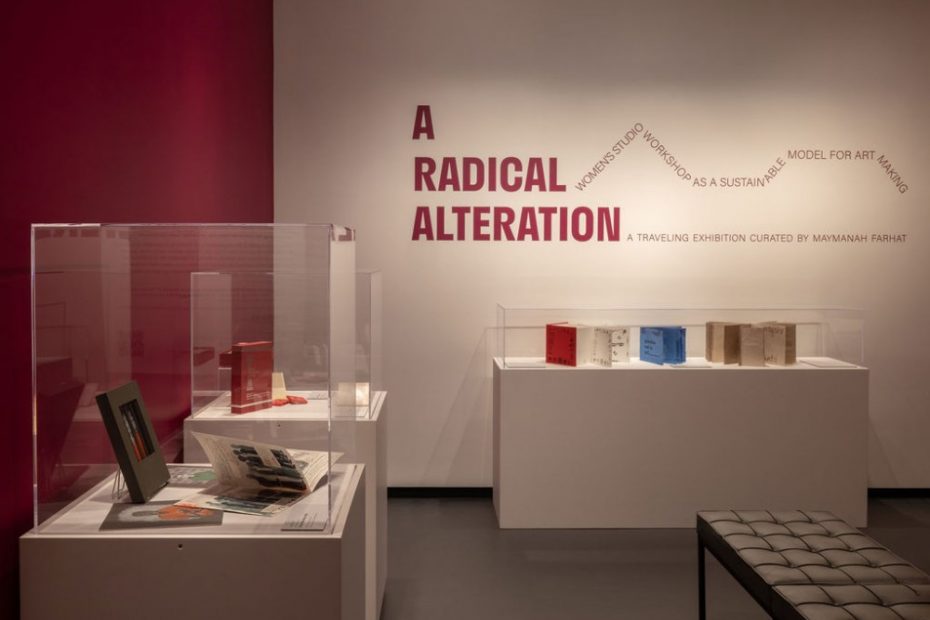For over 50 years, the Women’s Studio Workshop in Kingston, NY, has served as a beacon of what our world would look like if women’s art was integral to the cultural mainstream. The WSW provides an artists’ workspace that encourages the voice and vision of women, trans, intersex, nonbinary, and genderfluid artists. The WSW is adamant that they can continue to honor their core values and address gender equity more fully by explicitly expanding their concept of gender beyond patriarchal frames of reference. They proudly have a flexible definition of being a “women’s” studio, which allows for inclusivity of fluid and non-binary gender identities.
The National Museum of Women in the Arts (NMWA) is currently honoring the critical legacy of WSW with an exhibition that explores WSW as a model for radical change. A Radical Alteration: Women’s Studio Workshop as a Sustainable Model for Art Making, curated by Maymanah Farhat, is on view through the end of September. It celebrates the organization’s history as a proponent of book arts for marginalized communities in the US, featuring over 40 objects—artists’ books, zines, ephemera, and archival materials—dating from 1974 to 2024. Farhat elaborates on WSW’s impact and the exhibition below.
(Conversation lightly edited for length and clarity.)
What is your relationship to the Women’s Studio Workshop and book arts? Why was this the exhibition you felt the urge to curate?
Prior to curating WSW’s 50th anniversary exhibition, I only knew the organization from afar, through artists who had spent time there and through a former board member. I was asked to submit a proposal for a traveling exhibition that would highlight the organization’s history with a focus on its artist’s book program. I thought that curating the exhibition would offer an opportunity to learn more about WSW, its origin story and founders, and the many artists it has supported.
My curatorial practice is research-driven and focuses on underrepresented artists and forgotten art scenes, so this project was yet another way for me to document an overlooked history and community of artists.
What makes Women’s Studio Workshop such a special and vital organization?
WSW began as a grassroots initiative. It was co-founded by four women artists who wanted to empower other women with the knowledge and skills needed to work in a variety of media. They were also wholly committed to the working class community that lived in the small town in upstate New York where they launched the organization.
They are one of the few remaining feminist arts orgs founded in the 1970s, during a wave of artists-run collectives and art spaces, specifically those run by women and BIPOC artists.
Can you speak to the power of the artist book as a form? What makes the book arts medium so compelling?
Book arts have been around for centuries, from Late Antiquity to more recent experiments in contemporary art, like the movement that emerged in the U.S. in the 1960s. It’s a familiar medium, yet it continues to innovate in form, concept, and content by artists from around the world. It’s a universal art form in the truest sense. This makes it extremely accessible; it’s a form that people recognize and feel connected to. These socio-cultural aspects make it ideal for artists who want to reflect on difficult or deeply personal subject matter, while connecting to viewers.
In your eyes as the curator, what are some of the highlights of the exhibition?
Every work included in the show speaks of the strength of WSW’s artist’s book residency. It makes evident the extent to which the organization’s co-founders and subsequent staff supported the individual vision and experiments of each artist who participated in the program.
What aspect of the exhibition are you proudest of?
The show aims to outline how the co-founders of WSW were able to develop an organization that could last the ever-changing political, social, and cultural landscapes of the U.S., which have not always been easy or hospitable to artists, especially women and BIPOC artists. My hope with curating this exhibition was that I would be able to provide a template for sustainability that both artists and arts organizations could look to for inspiration.
I think the show is successful because its content not only remains relevant but urgent at this time. That isn’t due to my curatorial vision, but rather the initial mission of the organization and the strong sense of commitment of WSW’s co-founders.
The post The NMWA Honors 50 Years of the Women’s Studio Workshop appeared first on PRINT Magazine.
